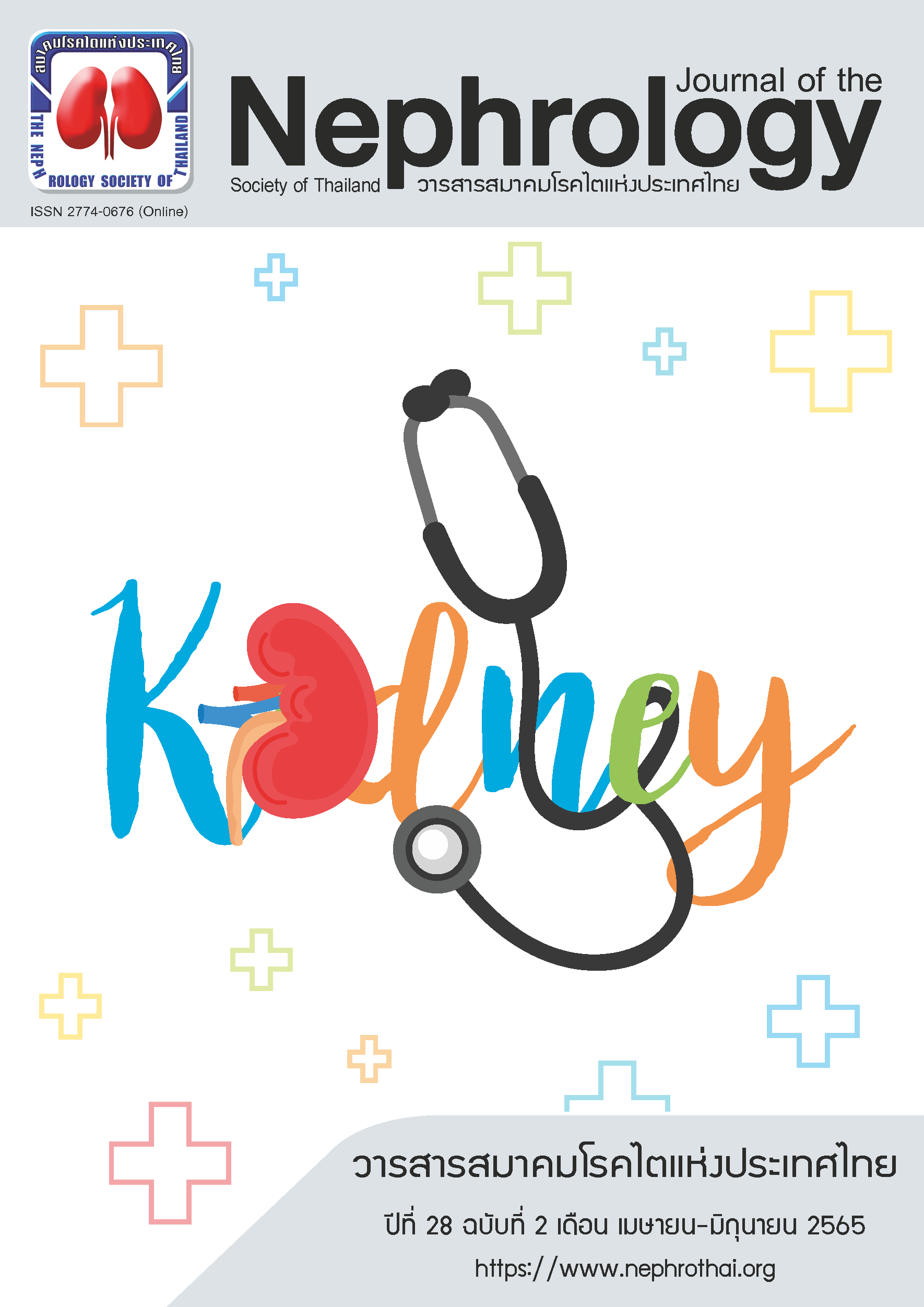Efficacy and safety of intermittent bolus compared with continuous drip of 3%NaCl in patients with severe symptomatic hyponatremia in Rajavithi Hospital
Main Article Content
Abstract
Background: Recently, the European Renal Best Practices (ERBP) recommended bolus 3%NaCl 150 mL every 20 min to target plasma sodium (pNa) of 5 mEq/L during the first hour among patients with severe symptomatic hyponatremia. This recommendation was based on expert opinions reported in small scale studies.
Methods: This constituted a single center, open label, randomized controlled trial including patients with severe symptomatic hyponatremia (pNa <125 mEq/L). Patients were randomized to an intermittent bolus group (IB) treated with 150 mL of 3%NaCl every 20 mins and a continuous drip group (CD) treated with 1 mL/kg/h of 3%NaCl to achieve the target pNa ≥5 mEq/L to improve symptoms. The primary end points were changes in pNa and Glasglow Coma Scale (GCS) at the 6th hour.
Results: Seven patients were randomized to IB and 6 patients to CD. Four patients were terminated during the study, 2 patients in IB and 2 patients in the CD group, respectively. The IB group exhibited higher serum urea and uric acid than the CD group. No differences were found regarding changes of pNa and GCS at the 6th hour between IB and CD groups. Time to target pNa and time to normalize symptoms trended to be less in the IB group. Overcorrection rate at the 24th and 48th hour tended to be less in the IB group. Two patients in the CD group needed relowered protocol. No differences were found in changes of pNa, and GCS at the 24th and 48th hour including length of hospital stay, and no ODS or mortality rate changes were noted in 30 days.
Conclusion: Changes of pNa and GCS after correcting hyponatremia with 3%NaCl intermittent bolus compared with continuous drip did not significantly differ by preliminary analysis. Intermittent bolus showed a trend to achieve target pNa and cure pNa symptoms rapidly.
Trial registration: ClinicalTrials.gov identifier: NCT04561531
Article Details

This work is licensed under a Creative Commons Attribution-NonCommercial-NoDerivatives 4.0 International License.
This article is published under CC BY-NC-ND 4.0 license, which allows for non-commercial reuse of the published paper as long as the published paper is fully attributed. Anyone can share (copy and redistribute) the material in any medium or format without having to ask permission from the author or the Nephrology Society of Thailand.
References
Spasovski G, Vanholder R, Allolio B, Annane D, Ball S, Bichet D, et al. Clinical practice guideline on diagnosis and treatment of hyponatraemia. Eur J Endocrinol. 2014;170(3): G1-47.
Ayus JC, Krothapalli RK, Arieff A I. Treatment of symptomatic hyponatremia and its relation to brain damage. A prospective study. N Engl J Med.1987 Nov 5;317(19): 1190-5.
Adrogu´ HJ, Madias NE. Hyponatremia. N Engl J Med.2000; 342(21):1581-9.
Sterns RH, Hix JK, Silver St. Treatment of hyponatremia. Curr Opin Nephrol Hypertens. 2010; 19(5):493-8.
Ball SG, Iqbal Z. Diagnosis and treatment of hyponatraemia. Best Pract Res Clin Endocrinol Metab. 2016; 30(2):161-73.
Sterns RH, Nigwekar SU,Hix JK. The treatment of hyponatremia. Semin Nephrol. 2009; 29(3):282-99.
Hegazi MO, Nawara A. Prevention and treatment of the osmotic demyelination syndrome. JSM Brain Sci.2016; 1:1004.
Lambeck J, Hieber M, Dreßing A, Niesen WD. Central pontine myelinolysis and osmotic demyelination syndrome. Dtsch Arztebl Int. 2019; 116: 600–6.
Bernard R. Fundamentals of biostatistics. 5thed: Duxbury Press; 2000.
Garrahy A, Dineen R, Hannon AM, Cuesta M, Tormey W, Sherlock M, et al. Continuous versus bolus infusion of hypertonic saline in the treatment of symptomatic hyponatremia caused by SIAD. J Clin Endocrinol Metab.2019; 104(9):3595-602.
Ellison DH, Berl T. Clinical practice. The syndrome of inappropriate antidiuresis. N Engl J Med. 2007;356(20):2064-72.
Filippone EJ, Ruzieh M, Foy A. Thiazide-Associated Hyponatremia: Clinical Manifestations and Pathophysiology. Am J Kidney Dis.2020; 75(2):256-64.
Baek SH, Jo YH, Ahn S, Medina-Liabres K, Oh Y K, Lee J B, et al. Continuous Versus Bolus Infusion of Hypertonic Saline in the Treatment of Symptomatic Hyponatremia Caused by SIAD. JAMA Intern Med.2021; 181(1):81-92.
Sterns RH, Osmotic demyelination syndrome (ODS) and overly rapid correction of hyponatremia. In: Emmett M, Forman JP, editors. UpToDate [Internet]. Waltham (MA): UpToDate Inc; 2021 [cited 2021 Apr 18]. Available from: https://www.uptodate.com/contents/osmotic-demyelinationsyndrome-ods-and-overly-rapid-correction-ofhyponatremia#H1791857537.
Mozes B, Pines A, Werner D, Olchovsky D, Lieberman P, Frankl O. Thiazide-induced hyponatremia: an unusual neurologic course. South Med J.1986; 79(5):629-31.


